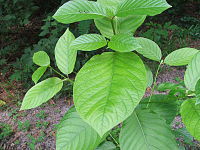
Photo from wikipedia
Abstract Background Traditional Chinese medicine (TCM) prescriptions have multiple bioactive properties. “Gui Zhi–Shao Yao” herb pair is widely used to treat chronic pain (CP), as well as anxiety and depression.… Click to show full abstract
Abstract Background Traditional Chinese medicine (TCM) prescriptions have multiple bioactive properties. “Gui Zhi–Shao Yao” herb pair is widely used to treat chronic pain (CP), as well as anxiety and depression. However, its related targets and underlying mechanisms have not been deciphered. Methods In this study, the network pharmacology method was used to explore the bioactive components and targets of “Gui Zhi–Shao Yao” herb pair and further elucidate its potential biological mechanisms of action in the treatment of CP with comorbid anxiety disorder (AD) and mental depression (MD). Results Following a series of analyses, we identified 15 active compounds, hitting 130 potential targets. After the intersections the targets of this herb pair and CP, AD and MD – sorted by the value of degree – nine targets were identified as the vital ones: Akt1, IL6, TNF, PTGS2, JUN, CASP3, MAPK8, PPARγ and NOS3. Gene ontology (GO) and Kyoto Encyclopedia of Genes and Genomes (KEGG) analysis results demonstrated 11 pathways, such as AGE-RAGE signalling pathway, IL-17 signalling pathway, TNF signalling pathway, which primarily participate in the pathological processes. Conclusions This study preliminarily predicted and verified the pharmacological and molecular mechanisms of “Gui Zhi–Shao Yao” herb pair for treating CP with comorbid AD and MD from a holistic perspective. In vivo and in vitro experiments will be required to further investigate the mechanisms. KEY MESSAGE A network pharmacology approach was applied to identify key targets and molecular mechanisms. Nine targets were regarded as the vital targets for chronic pain with comorbid anxiety and depression. Predicted 11 pathways were the potential therapy targets and pharmacological mechanism of “Gui Zhi–Shao Yao” herb pair.
Journal Title: Annals of Medicine
Year Published: 2022
Link to full text (if available)
Share on Social Media: Sign Up to like & get
recommendations!